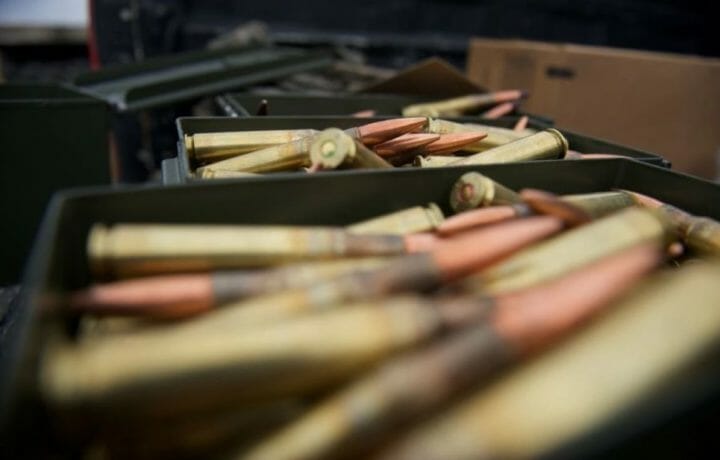The United States military’s stockpile of ammunition, notably the 155mm ordnance that is widely used throughout the NATO alliance, remains undersupplied. The ongoing conflict in Ukraine and the U.S.’s past support, resulted in significantly depleted stockpiles, while the U.S. Army has struggled to keep up with production. The issue has been ongoing, even as it was announced last year that production would be ramped up, while a goal of 100,000 rounds a month was set.
The 155mm round, which is used in the M777 howitzer, is produced at the Iowa Army Ammunition Plant in Des Moines County, IA. The facility, which is part of the U.S. Army Joint Munitions Command, is currently operated by American Ordnance, LLC. In addition, General Dynamics operates a facility in Mesquite, TX, which builds 155mm shell casings, while the Scranton Army Ammunition Plant in Pennsylvania also produces 155mm artillery shells.
Prior to Russia’s unprovoked invasion of Ukraine more than three years ago, which was followed by the U.S. providing aid, including the 155mm ordnance, U.S. production of the rounds was around 14,400 shells monthly. The ongoing conflict, which has included artillery slug matches reminiscent of the First World War, has seen both sides burn through vast quantities of ammunition, and supplies couldn’t keep up with demand.
Increasing 155mm Production
This week, the U.S. Army and General Dynamics Ordnance and Tactical Systems announced that a new load, assemble and pack (LAP) facility for the ordnance was opened at Camden, AR. It will expand the production capacity of the 155mm artillery rounds, and aid restoring the industrial base.
“The Army must transform and get war-winning capabilities into the hands of soldiers now, including key munitions. The Camden load, assembly, and pack munitions facility is just one of several modernization investments the Army is making to reinforce and strengthen our defense industrial base,” said Secretary of the Army Dan Driscoll.
“The Army remains committed to delivering relevant munitions at speed and scale to our soldiers, the joint force, and allies and partners. It is not lost on us that a key component of victory on the battlefield starts in our production facilities,” Driscoll added.
The Army had previously announced it would spend around $3.1 billion as part of the fiscal year 2024 (FY24) supplemental funding to increase the production of artillery shells, including the 155mm rounds.
Not a New Production Plant
It is important to note that the LAP facility isn’t a full production plant, rather it just completed the final stage in artillery projectile production. At the Camden facility, 155 mm metal projectile bodies are filled with explosive material, assembled with other components, and packed for shipment. It currently features two new LAP lines that will produce completed high-explosive projectiles at a rate of 50,000 per month when fully operational.
The facility was established as part of a coordinated effort by the U.S. Army to increase the monthly output of 155 mm artillery projectiles to 100,000 per month.
“Since 2022, the Army has nearly quadrupled its monthly production of this critical munition – driven by efforts to improve readiness, respond to global demands, and incorporate lessons learned from current conflicts,” the service explained.
The LAP facility opened on April 22
“[It] is the result of a robust partnership between industry, local, state, and federal government teammates,” added Pat Mason, senior official performing the duties of the assistant secretary of the Army (Acquisition, Logistics and Technology). “All parties worked quickly and flexibly to accelerate the construction you see around you.”
The service further suggested that the new LAP facility could help bring the Army’s industrial base “into the 21st century by leveraging new technologies and incorporating advanced automation and digital quality tracking for improved consistency and throughput.” It will soon introduce a next-generation air-cooling system for explosive curing to reduce water use in contrast to legacy cooling methods. Such investments could significantly strengthen U.S. munition production capabilities and serve as a credible deterrent to adversaries.
The U.S. Department of Defense has also expanded production capabilities, awarding contracts to Day & Zimmermann and IMT Defense in Ontario, Canada.
However, as reported last year, it isn’t just a matter of issuing additional contracts. There has been a shortage of key explosives – notably IMX-104 and TNT – that are required for the production of the 155mm shells. Each round requires 22 pounds of explosives, meaning the U.S. will need 26.4 million pounds of explosives monthly.
To meet the demand, production at the Holsten Army Ammunition Plant in Tennessee, which had been producing five million pounds of IMX-104 annually. As of last year, there was no TNT production in the U.S., and its supplies come from allies including Australia and India. Poland is a major supplier, and while the U.S. Army signed a contract with the Polish Nitro-Chem chemical plant last October, Poland is also struggling to meet its own demands.




